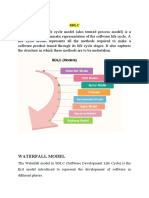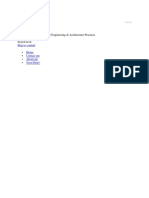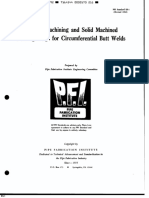Software Testing Notes-1
Uploaded by
sachinSoftware Testing Notes-1
Uploaded by
sachinIterative model
In this model of software development life cycle, the iterative method begins with a simple
execution of the small group of the requirements.Every release of the Iterative Model finishes
in an exact and fixed period that is called iteration. An iterative life cycle model doesn’t begin
with a complete set of requirements by the client, so it is easier to use.
The Iterative Model allows the accessing earlier phases, in which the variations made
respectively. The final output of the project renewed at the end of the Software Development
Life Cycle (SDLC) process.
When to use the Iterative Model?
• When requirements are defined clearly and easy to understand.
• When the software application is large.
• When there is a requirement of changes in future.
Advantage of Iterative Model
• Testing and debugging during smaller iteration is easy.
• A Parallel development can plan.
• It is easily acceptable to ever-changing needs of the project.
• Risks are identified and resolved during iteration.
Ekta Barlota 8983159233 ekta224286@gmail.com
• Limited time spent on documentation and extra time on designing.
Incremental Model
• Incremental Model is a process of software development where requirements
divided into multiple standalone modules of the software development cycle.
• In this model, each module goes through the requirements, analysis,design,
implementation,testing,deployment and maintenance phases
When we use the Incremental Model?
• When the requirements are superior.
• A project has a lengthy development schedule.
• When Software team are not very well skilled or trained.
• When the customer demands a quick release of the product.
• You can develop prioritized requirements first
Advantage of Incremental Model
• Errors are easy to be recognized.
• Easier to test and debug
• More flexible.
Ekta Barlota 8983159233 ekta224286@gmail.com
• Simple to manage risk because it handled during its iteration.
• The Client gets important functionality early.
Disadvantage of Incremental Model
• Need for good planning
• Total Cost is high.
• Well defined module interfaces are needed.
V- Model
• V-Model also referred to as the Verification and Validation Model(V-V).
• In this, each phase of SDLC must complete before the next phase starts. It follows a
sequential design process same as the waterfall model.
• Testing is planned in parallel with a corresponding stage of development
Ekta Barlota 8983159233 ekta224286@gmail.com
Verification and validation
Verification:
I t involves a static analysis method (review) done without executing code. It is the process of
evaluation of the product development process to find whether specified requirements meet.
Are we building the product right?
Validation:
I t involves dynamic analysis method (functional, non-functional), testing is done by executing
code. Validation is the process to classify the software after the completion of the development
process to determine whether the software meets the customer expectations and requirements.
Are we building the right product?
V-Model contains Verification phases on one side of the Validation phases on the other side.
Verification and Validation process is joined by coding phase in V-shape. Thus it is known as V-Model
When to use V-Model?
• When the requirement is well defined and not ambiguous.
• The V-shaped model should be used for small to medium-sized projects where requirements
are clearly defined and fixed.
• The V-shaped model should be chosen when technical resources are available with
essential technical expertise.
Advantage of V-Model
• Easy to Understand.
• Testing Methods like planning, test designing happens well before coding.
• This saves a lot of time. Hence a higher chance of success over the waterfall model.
• Works well for small plans where requirements are easily understood.
Ekta Barlota 8983159233 ekta224286@gmail.com
Disadvantage of V-Model
• Very rigid and least flexible.
• Not a good for a complex project.
• Software is developed during the implementation stage, so no early prototypes of the software
are produced.
• If any changes happen in the midway, then the test documents along with the required
documents, has to be updated
Agile Methodology
• Agile SDLC is a combination of iterative and incremental models.
• In Agile SDLC, the system or the product breaks down into small incremental builds.
• Each release carefully tested to make sure that the quality of the software maintained.
• Agile software model leveraged for time-critical software applications or apps.
• Agile methods break tasks into smaller iterations, or parts do not directly involve long term
planning.
• Each iteration is considered as a short time "frame" in the Agile process model, which typically
lasts from one to four weeks
• Each iteraton involves a team working through a full software development life cycle including
planning, requirements analysis, design, coding, and testing before a working product is
demonstrated to the client.
Ekta Barlota 8983159233 ekta224286@gmail.com
Ekta Barlota 8983159233 ekta224286@gmail.com
Reasons to Use this
● Teamwork and cross-training promoted.
● It provides flexibility to the programmers.
● Suitable for the projects while the requirements change gradually.
● Manage easily.
● Best fit for DevOps model projects
● It is best for changing or fixed requirements.
Advantages of Agile
● Frequent Delivery
● Face-to-Face Communication with clients.
● Efficient design and fulfils the business requirement.
● Anytime changes are acceptable.
● It reduces total development time.
Disadvantages Of Agile
● Due to the shortage of formal documents, it creates confusion and crucial decisions taken
throughout various phases can be misinterpreted at any time by different team members.
● Due to the lack of proper documentation, once the project completes and the developers
allotted to another project, maintenance of the finished project can become a difficulty.
Spiral model
● The spiral methodology merges the possibility of iterative improvement with some of
the controlled parts of the waterfall model.
● The spiral methodology merges the possibility of iterative improvement with some of the
controlled parts of the waterfall model.e iterative development model and the waterfall model.
Ekta Barlota 8983159233 ekta224286@gmail.com
Advantages -
• Software is produced early in the software life cycle.
Risk handling is one of important advantages of the Spiral model, it is best development
model to follow due to the risk analysis and risk handling at every phase.
Flexibility in requirements. In this model, we can easily change requirements at later phases
and can be incorporated accurately. Also, additional Functionality can be added at a later
date.
• It is good for large and complex projects.
• It is good for customer satisfaction. We can involve customers in the development of
products at early phase of the software development. Also, software is produced early in the software
life cycle.
Strong approval and documentation control.
It is suitable for high risk projects, where business needs may be unstable. A highly customized
product can be developed using this.
Disadvantages
• It is not suitable for small projects as it is expensive.
• It is much more complex than other SDLC models. Process is complex.
• Too much dependable on Risk Analysis and requires highly specific expertise.
Ekta Barlota 8983159233 ekta224286@gmail.com
• Difficulty in time management. As the number of phases is unknown at the start of the
project, so time estimation is very difficult.
• Spiral may go on indefinitely.
• End of the project may not be known early.
• It is not suitable for low risk projects.
• May be hard to define objective, verifiable milestones. Large numbers of intermediate
stages require excessive documentation.
when to use
• When cost and risk Analysis is important
• Medium to high risk project
• Long term commitment
• Complex reqd significant change expected
Phases of spiral
• Planning phase- BRD and SRS
• Risk Analysis- Identify risk and create prototype
• Engineering phase -Software development and Testing at each phase
• Evaluation phase- Allow customer to evaluate the output of project to date before the project
Ekta Barlota 8983159233 ekta224286@gmail.com
Questionaire
1. what is software testing
2. why you choose tester as your career
3.whois a good tester
4. whta is the difference between project and product
5.what is SDLC
6.what is a software project
7. With how many tester did you work in your project
8. what is static testing
9. what is dyanamic testing
10. difference between static and dynamic testing
11.when does testing start befoe or after coding
12. what is snapshot ?
13.Who create snapshot?
14. what is V model
15.what is iteration model
16. what is low level design
17 what is high level design
18. what is prototype
19. what is review ? Did you got a change to take part in it
20. what is gray , white, grey box testing
21. mention issues faced during your project
22. when do we use itterative model ?
23. difference between BRD and SRS ?
Ekta Barlota 8983159233 ekta224286@gmail.com
24. tell me about your self
25. what is coding
26.what did you like most working on your project ?
Ekta Barlota 8983159233 ekta224286@gmail.com
You might also like
- 1 Software Development and Process ModelNo ratings yet1 Software Development and Process Model40 pages
- Iterative, Spiral and V, Big Bang ModelNo ratings yetIterative, Spiral and V, Big Bang Model16 pages
- Software Models in Software EngineeringNo ratings yetSoftware Models in Software Engineering28 pages
- Types of Software Developing Life CyclesNo ratings yetTypes of Software Developing Life Cycles11 pages
- (Original Size) Colorful Minimalist Linear Steps Circular DiagramNo ratings yet(Original Size) Colorful Minimalist Linear Steps Circular Diagram8 pages
- Q3 Module3 G9 Computer-Programming Bautista-NHS-1No ratings yetQ3 Module3 G9 Computer-Programming Bautista-NHS-110 pages
- Introduction To Software Engineering: Week 3 (Lecture 5,6) Maha ButtNo ratings yetIntroduction To Software Engineering: Week 3 (Lecture 5,6) Maha Butt65 pages
- Laboratory Exercise (Software Development Projects/Software Life Cycle Models)No ratings yetLaboratory Exercise (Software Development Projects/Software Life Cycle Models)5 pages
- What Are The Software Development Models?: Waterfall ModelNo ratings yetWhat Are The Software Development Models?: Waterfall Model10 pages
- TOS 3 Unit 3b Principles of Load Bearing Structures-167% (3)TOS 3 Unit 3b Principles of Load Bearing Structures-118 pages
- India Security Press Nashik Exam Pattern: SL - No Name of Test No - of Questions Marks DurationNo ratings yetIndia Security Press Nashik Exam Pattern: SL - No Name of Test No - of Questions Marks Duration3 pages
- College of Engineering, Computer Studies and Architecture Course Learning Plan For Geotechnical Engineering 1 CourseNo ratings yetCollege of Engineering, Computer Studies and Architecture Course Learning Plan For Geotechnical Engineering 1 Course2 pages
- Thapar Institute of Engineering & Technology, Patiala: First Online Counselling:: Branch/Category Wise Cut-OffNo ratings yetThapar Institute of Engineering & Technology, Patiala: First Online Counselling:: Branch/Category Wise Cut-Off5 pages
- Modelling and Seismic Response Analysis of Italian Pre Code and Low Code Reinforced Concrete Buildings Part I Bare FramesNo ratings yetModelling and Seismic Response Analysis of Italian Pre Code and Low Code Reinforced Concrete Buildings Part I Bare Frames33 pages
- PFI ES-1-1992 Internal Machining and Solid Machined Backing Rings For Circumferential Butt Welds PDFNo ratings yetPFI ES-1-1992 Internal Machining and Solid Machined Backing Rings For Circumferential Butt Welds PDF8 pages
- (Original Size) Colorful Minimalist Linear Steps Circular Diagram(Original Size) Colorful Minimalist Linear Steps Circular Diagram
- Introduction To Software Engineering: Week 3 (Lecture 5,6) Maha ButtIntroduction To Software Engineering: Week 3 (Lecture 5,6) Maha Butt
- Laboratory Exercise (Software Development Projects/Software Life Cycle Models)Laboratory Exercise (Software Development Projects/Software Life Cycle Models)
- What Are The Software Development Models?: Waterfall ModelWhat Are The Software Development Models?: Waterfall Model
- Everything that you MUST know as an IT Scrum MasterFrom EverandEverything that you MUST know as an IT Scrum Master
- TOS 3 Unit 3b Principles of Load Bearing Structures-1TOS 3 Unit 3b Principles of Load Bearing Structures-1
- India Security Press Nashik Exam Pattern: SL - No Name of Test No - of Questions Marks DurationIndia Security Press Nashik Exam Pattern: SL - No Name of Test No - of Questions Marks Duration
- College of Engineering, Computer Studies and Architecture Course Learning Plan For Geotechnical Engineering 1 CourseCollege of Engineering, Computer Studies and Architecture Course Learning Plan For Geotechnical Engineering 1 Course
- Thapar Institute of Engineering & Technology, Patiala: First Online Counselling:: Branch/Category Wise Cut-OffThapar Institute of Engineering & Technology, Patiala: First Online Counselling:: Branch/Category Wise Cut-Off
- Modelling and Seismic Response Analysis of Italian Pre Code and Low Code Reinforced Concrete Buildings Part I Bare FramesModelling and Seismic Response Analysis of Italian Pre Code and Low Code Reinforced Concrete Buildings Part I Bare Frames
- PFI ES-1-1992 Internal Machining and Solid Machined Backing Rings For Circumferential Butt Welds PDFPFI ES-1-1992 Internal Machining and Solid Machined Backing Rings For Circumferential Butt Welds PDF

























































































